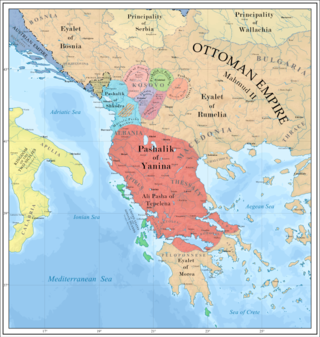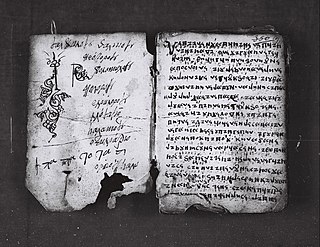The Albanian alphabet is a variant of the Latin alphabet used to write the Albanian language. It consists of 36 letters:
The Vithkuqi alphabet, also called Büthakukye or Beitha Kukju after the appellation applied to it by German Albanologist Johann Georg von Hahn, was an alphabetic script invented for writing the Albanian language between 1825 and 1845 by Albanian scholar Naum Veqilharxhi.
The Elbasan alphabet is a mid 18th-century alphabetic script created for the Albanian language Elbasan Gospel Manuscript, also known as the Anonimi i Elbasanit, which is the only document written in it. The document was created at St. Jovan Vladimir's Church in central Albania, but is preserved today at the National Archives of Albania in Tirana. The alphabet, like the manuscript, is named after the city of Elbasan, where it was invented, and although the manuscript isn't the oldest document written in Albanian, Elbasan is the oldest out of seven known original alphabets created for Albanian. Its 59 pages contain Biblical content written in a script of 40 letters, of which 35 frequently recur and 5 are rare.
Ioannis "Yianis" Vilaras was a Greek doctor, lyricist and writer who often discussed linguistic matters and maintained ties with many figures of the Modern Greek Enlightenment movement.

Codex Purpureus Beratinus designated by Φ or 043, ε 17, is an uncial illuminated manuscript Gospel book written in Greek. Dated palaeographically to the 6th-century, the manuscript is written in an uncial hand on purple vellum with silver ink. The codex is preserved at the Albanian National Archives in Tirana, Albania. It was formerly possessed by the St. George Church in the town of Berat, Albania, hence the 'Beratinus' appellation.

Minuscule 1143, ε 1035, also known as the Beratinus 2, or Codex Aureus Anthimi. It is a Greek minuscule manuscript of the New Testament on purple parchment, dated paleographically to the 9th century. This is one of the seven “purple codices” in the world to have survived to the present day, and one of the two known purple minuscules written with a gold ink.

The Pashalik of Yanina, sometimes referred to as the Pashalik of Ioannina or Pashalik of Janina, was an autonomous pashalik within the Ottoman Empire between 1787 and 1822 covering large areas of Albania, Greece, and North Macedonia. Under the Ottoman Albanian ruler Ali Pasha, the pashalik acquired a high degree of autonomy and even managed to stay de facto independent, though this was never officially recognized by the Ottoman Empire. Conceiving his territory in increasingly independent terms, Ali Pasha's correspondence and foreign Western correspondence frequently refer to the territories under Ali's control as Albania.

Porto Palermo Castle is a castle near Himarë in southern Albania. It is situated in the bay of Porto Palermo, a few kilometers south of Himarë along the Albanian Riviera. The area together with Llamani beach will be proclaimed a protected area holding the status of Protected Landscape by the Albanian Government. It is the most well preserved garrison erected by Ali Pasha in the region.
A bejtexhi was a popular bard of the Muslim tradition in Ottoman Albania. The genre of literature created by bejtexhinj in the 18th century prevailed in different cities of what is now Albania, Kosovo, Chameria as well as in religious centers.

Naum Veqilharxhi was an Albanian lawyer and scholar. In 1844, he published using a unique alphabet for the Albanian language with characters he had created himself, the Vithkuqi script. Veqilharxhi is one of the most prominent figures of the early Albanian National Awakening, and is considered by Albanians as its first ideologue.

Saint Jovan Vladimir's Church is a church in Shijon, Elbasan County, Albania. It is dedicated to the Dukljan prince and saint Jovan Vladimir, the son-in-law of the Bulgarian Tsar Samuil. It became a Cultural Monument of Albania in 1948. The first temple is the oldest large Orthodox basilica from the times of Tsar Samuil, rebuilt as present church by the Thopia family in 1381. Karl Thopia, the Prince of Albania, died in 1388 and was buried in Saint John Vladimir's Church.

The Sanjak of Elbasan was one of the sanjaks of the Ottoman Empire. Its county town was Elbasan in Albania.

The Elbasan Gospel Manuscript is an 18th-century collection of translations from the New Testament into Albanian. Although the author is mainly known as the Anonymous of Elbasan, according to Mahir Domi and Robert Elsie the linguistic and historical evidences indicate to be the work of Gregory of Durrës. On the cover's verso with the same ink as the text, something has been written in a different script, which has been interpreted by a historian as ‘Theodoros Bogomilos / Papa Totasi’, although this tentative interpretation isn't universally accepted. For this reason the work is sometimes attributed to Totasi as the owner, if not the creator of the manuscript.
The House of Taushani was an Albanian aristocratic family prominent from the 15th to 19th century. According to prof. Stavri Naci, the most powerful families of Albania that played an important economic and political role were, "in Shkoder, the Bushati and Caushollaj; in Peja, Begollaj; in Elbasan, Taushani and Bicaku; in Vlora, Velabishtaj and Vlora; in Delvina, Kapllanpashalli; in Krujë, Toptani; and in Kavaja, the Alltuni."
Constantine of Berat, known among Albanians as Kostandin Jermonak Berati or shortly Kostë Berati, was an Albanian writer and translator of the 18th century.
The Second Congress of Manastir was an Albanian congress held on 2–3 April 1910 in Manastir, back then Ottoman Empire, today's Bitola in the Republic of North Macedonia. It dealt with the challenges that the Albanian language and schools faced at the time within the context of the empire, and the platform to overcome them.
The Vrioni were an aristocratic Albanian family and one of the largest landowners of Albania, otherwise known as "Konaqe" or "Oxhaqe", among which the most important are: Vrioni of Berat and Fier, Vloraj of Vlora, Toptani of Tirana, Biçakçinjtë of Elbasan, Dino of Ioannina and Preveza, Vërlaci of Elbasan, Bushatllinjtë of Shkodra, Këlcyrajt of Këlcyra, Markagjonët of Mirdita, etc. Insignia titles held by members of these families, usually Pasha or Bey, corresponded to the assigned positions in the Ottoman administration, central or local, which are given by ferman or berat (decrees) by the Sultan of the Ottoman Empire.

The Todhri alphabet is an 18th-century Albanian alphabetical writing system invented for writing the Albanian language by Theodhor Haxhifilipi, also known as Dhaskal Todhri.

Gregory of Durrës was an Albanian scholar, printer, typographer, teacher, and Eastern Orthodox Christian monk and cleric of Ottoman Albania who is thought to have invented a particular Albanian alphabetic script, the Elbasan script, used to write the Elbasan Gospel Manuscript. The manuscript is one of the oldest known pieces of Albanian Orthodox literature, as well as the oldest known Orthodox Bible translation into Albanian.

Theodhor Haxhifilipi, also known as Dhaskal Todhri, was a teacher from Elbasan, who is credited as an inventor of an original Albanian alphabet. The Todhri script, as is called because of him, according to Kostandin Kristoforidhi, was either invented by Theodor, or brought by him from Voskopojë. Theodhor is the author of numerous translations of liturgical works in Albanian, of which only a few survived. A mass of John Chrysostom, preserved in a later manuscript of 32 pages, is amongst the rare ones kept at the National Library of Albania.










